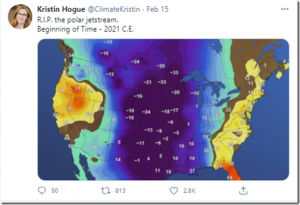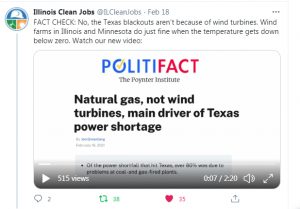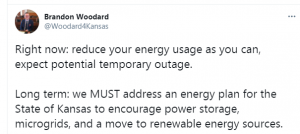Texas’ power collapse in the wake of record-setting cold left millions of people suffering without electricity. And millions more are left with big questions about how such a tragedy could happen. A disaster like this should spark thoughtful discussion in Illinois and across the country of what we can do to strengthen our grid and prevent such tragedies in the future. Here’s a breakdown:
What happened?

Beginning Sunday, Feb. 14, a winter storm brought record-low temperatures to Texas that crippled sources of power generation (mostly natural gas and coal). The limited electricity supply coupled with record-high demand forced the Electric Reliability Council of Texas (ERCOT)—the state’s power grid operator—early on the morning of Monday, Feb. 15, to implement rolling outages that left millions of people without power.
Why did ERCOT order rolling outages?
When a grid manager takes the extreme step of ordering controlled rolling blackouts (also called “load-shedding”), it’s to prevent an even bigger problem. The grid was reportedly minutes, even seconds, away from a total collapse—a blackout that could have lasted months.
How many people were affected?
We’ve seen estimates ranging from at least 2 million to 3.6 million or more. The initial plan was that the rolling blackouts would only last 15-45 minutes at a time, but then utility officials announced the outages would last hours, even days. By the end of the week, hundreds of thousands of people were still without power, about half of the state was under a boil order, and local TV stations had reported too many sad stories: In the Houston area, three young children and their grandmother died in a fire, likely sparked by a fireplace. In Abilene, a 67-year-old homeless man died of exposure, and a 60-year-old man froze to death in his own home. In Galveston County six deaths were suspected to have been caused by exposure or carbon monoxide poisoning.
While Texas was hit the hardest, millions of people across the country suffered through power outages amid harsh winter temperatures and the ongoing pandemic. The White House declared emergencies in Texas, Oklahoma and Louisiana, and on Saturday, Feb. 20, Texas received a “major disaster” declaration.
How can I help?
See a list of organizations taking donations here.
Is the Texas problem about wind turbines freezing?
No. Some officials initially blamed the problem on Texas wind turbines freezing in the record-low temps. But ERCOT data show that most of the outages were caused by natural gas supply constraints because of frozen wells and pipelines. “Though no power resource performed perfectly, power sector experts dismissed the idea that renewables alone were to blame for the outages,” Utility Dive wrote.

Note: The Illinois Clean Jobs Coalition, of which CUB is a member, produced a short video debunking this“frozen wind turbines are to blame” myth. If you want to do a deeper dive into the Texas disaster, check out these articles by The New York Times, The Texas Tribune and this detailed itemization of key issues surrounding the Texas power collapse from an interested observer in Australia. Also, we recommend you visit the Twitter feed of Jesse Jenkins, an energy systems engineer at Princeton University, for clear-headed analysis.
What does natural gas have to do with electricity?
Natural gas can be used to run power plants. It’s common for gas to be used for “peaker plants”—power plants exclusively used for periods when demand spikes. In Texas, the majority of power reserved for these peak times relies on gas. On the other hand, wind power is just a fraction (roughly 7 percent) of Texas’ power mix this time of year.
Could something like this happen in Illinois?
Disasters like this could happen anywhere, especially since we’re dealing with more volatile weather—both extreme cold and heat—caused by climate change. Illinois historically has had a healthy supply of electricity, and it has made improvements to the grid over the years to better withstand weather extremes. But we can’t be complacent in improving the grid, strengthening consumer protections and moving to 100% clean, affordable energy. That’s why we support the Clean Energy Jobs Act (CEJA). (See below.)
What lessons can we learn from the Texas disaster?
You don’t discover the cause of a fire in the middle of the blaze. So once Texas gets back on its feet, we look forward to analyzing the data to learn more about preventing such a tragedy in the future. However, there are some initial lessons we should take to heart in trying to improve electricity service for consumers, in Texas, Illinois and across the country.
1) Climate change should be a key part of our energy planning. Climate change is making extreme weather events, like in Texas, more frequent and more expensive. Whether the country is dealing with spring floods, summer tornadoes and hurricanes, or the winter polar vortex, we simply can’t protect the reliability and affordability of our energy supply without investing in clean energy that combats climate change. “This is why we  have to have the conversations about being resilient to address changing patterns in the climate. I don’t think this is the last time we’ll see rolling blackouts,” said one Kansas legislator, who wrapped himself in layers of clothing and blankets to get through the deep freeze.
have to have the conversations about being resilient to address changing patterns in the climate. I don’t think this is the last time we’ll see rolling blackouts,” said one Kansas legislator, who wrapped himself in layers of clothing and blankets to get through the deep freeze.
2) Consumer protections are key. One of the factors that makes Texas unique in the energy world is that it runs its own power grid. Because the grid doesn’t cross state lines, the Federal Energy Regulatory Commission does not oversee it. Each state has to determine the best way to manage its energy supply—there’s no one-size fits all approach—but no matter the approach, the customers and safeguards to protect them have to be the focus. In the coming months, we hope the Texas disaster offers insights into how Texas and all states can better protect electricity customers.
3) Innovation is key. Strong clean energy policy—and by “strong” we mean policy that moves us as quickly as possible to 100 percent clean energy, while protecting our bottom lines—must have data-based innovation at its core. Innovation isn’t a feel-good measure—the Texas disaster shows us it’s a necessity. It can help us solve how we better fortify our power grid from extreme weather, rethink the way we heat our homes and give consumers easier access to their own energy-usage data and money-saving efficiency tools. CUB’s Big Data Energy Center is filled with research on finding the quickest, most thoughtful and most consumer-friendly ways to secure reliable, affordable and clean energy in the coming years.
4) Proper planning is paramount. This isn’t the first time Texas has dealt with widespread blackouts. A decade ago, 3 million people were left without power, and federal regulators warned the state to take steps to better prepare its power plants for cold weather. Emily Grubert, assistant professor of civil and environmental engineering at Georgia Tech, told Utility Dive that the Texas tragedy is a lesson in being prepared. “It’s an argument that we need to think about how we’re designing a grid that is probably going to be subjected to more extremes than it has been in the past for climate change reasons, in particular,” she said.
Illinois already has a plan to help us avoid problems like Texas: the proposed Clean Energy Jobs Act (CEJA), which solves for climate change by designing the cheapest, fastest and most responsible way to 100 percent clean energy. CEJA ensures there will be a thorough integrated grid planning process through the Illinois Commerce Commission (ICC). Plus, its capacity market reforms guarantee more thoughtful state-based planning of resources so that Illinois has enough reserve power while avoiding slamming customers with needlessly higher costs.

